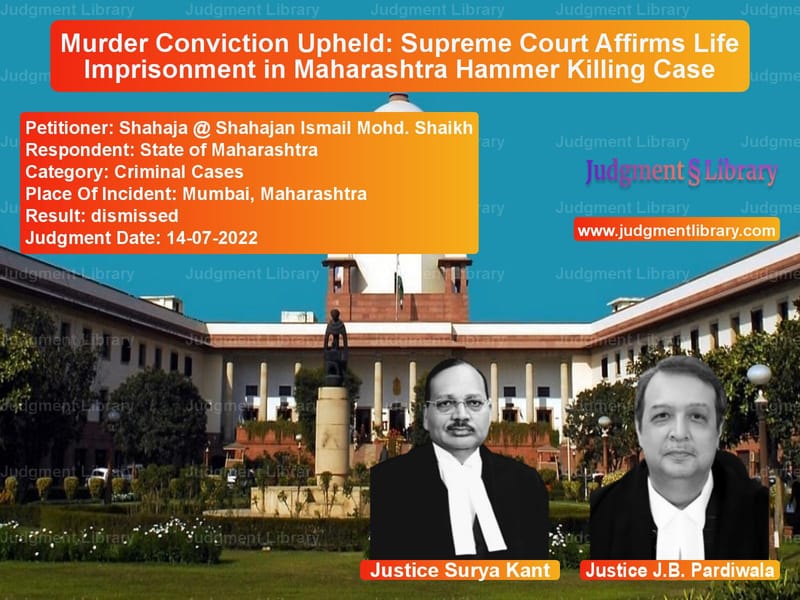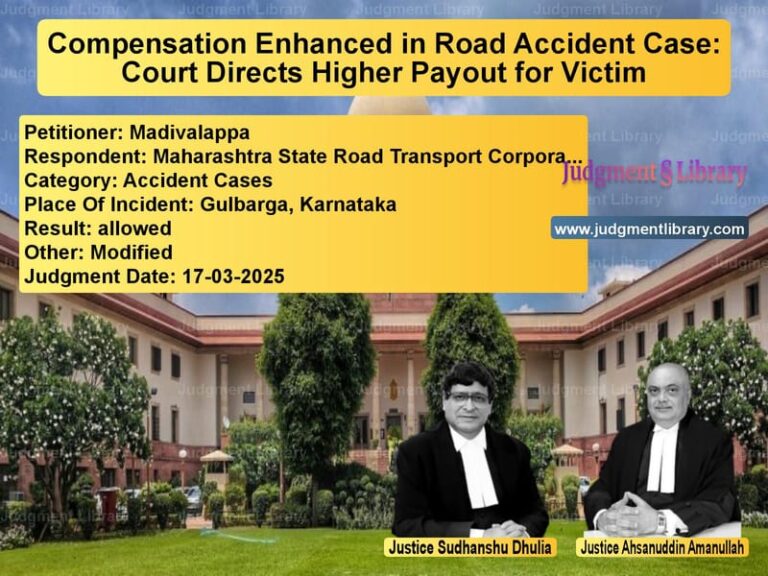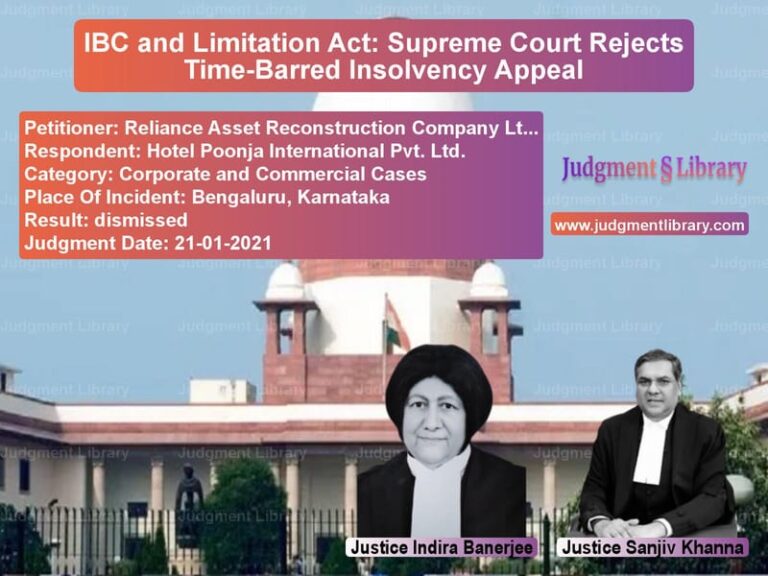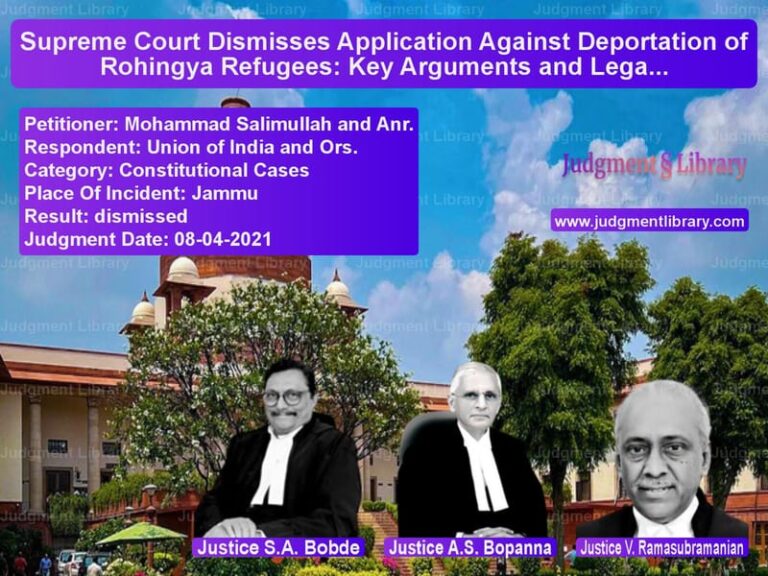Murder Conviction Upheld: Supreme Court Affirms Life Imprisonment in Maharashtra Hammer Killing Case
The case of Shahaja @ Shahajan Ismail Mohd. Shaikh vs. State of Maharashtra was a criminal appeal concerning the conviction of the appellant for murder under Section 302 of the Indian Penal Code (IPC). The Supreme Court, in its judgment delivered by Surya Kant and J.B. Pardiwala, upheld the decisions of the Bombay High Court and the Sessions Court, confirming the appellant’s life imprisonment.
The case revolved around a brutal hammer attack that resulted in the death of the victim, Mahankal Jaiswal. The key legal questions in this appeal pertained to the reliability of eyewitness testimony, forensic evidence, and the validity of a discovery panchnama under Section 27 of the Indian Evidence Act.
Background of the Case
The prosecution’s case was based on the following key facts:
- The appellant and the deceased were laborers working in the Vile Parle area of Mumbai and were acquainted with each other.
- On the night of 10 December 2006, a quarrel erupted between the appellant and the deceased near the ticket window of Vile Parle Railway Station.
- Later that night, while the deceased was sleeping on a bridge near the Hanuman Temple, the appellant allegedly struck him on the head with a hammer.
- The assault was witnessed by two individuals – PW-1 (Nandlal Ramnihor Mishra), a priest at the Hanuman Temple, and PW-8 (Udaysingh Ramsingh Thakur), another laborer sleeping nearby.
- The next morning, the police arrived at the scene and initiated an investigation.
Prosecution’s Case
The prosecution presented the following key pieces of evidence:
- Eyewitness Testimony: PW-1 and PW-8 stated they saw the appellant strike the deceased with a hammer.
- Confession-like Conduct: PW-1 testified that when he confronted the appellant immediately after the incident, the appellant admitted to killing the deceased.
- Medical Evidence: The post-mortem report, prepared by PW-6 (Dr. Shivaji Vishnu Kachare), confirmed that the cause of death was head trauma caused by a blunt weapon, consistent with a hammer.
- Discovery of Weapon: The appellant allegedly led the police to the location of the hammer, which was recovered under a panchnama recorded under Section 27 of the Indian Evidence Act.
- Forensic Evidence: The hammer was found to have human blood stains matching the deceased’s blood type.
Trial Court’s Judgment
The Sessions Court convicted the appellant and sentenced him to life imprisonment, relying on:
- The credibility of the eyewitnesses, PW-1 and PW-8.
- The appellant’s admission of the crime to PW-1.
- The forensic evidence linking the hammer to the crime.
- The recovery of the weapon at the appellant’s instance.
High Court’s Judgment
The appellant challenged the conviction before the Bombay High Court. However, the High Court upheld the trial court’s findings, emphasizing that:
- The eyewitness testimony was credible and consistent.
- The medical and forensic evidence corroborated the prosecution’s case.
- The recovery of the hammer was valid and further supported the case against the appellant.
- The appellant’s conduct after the crime (walking away from the scene with the hammer) indicated guilt.
Supreme Court’s Analysis
The Supreme Court considered whether the High Court had correctly upheld the conviction. The Court reaffirmed that in appeals against concurrent findings of guilt, its interference should be limited unless the judgment is perverse or based on an incorrect application of law.
Reliability of Eyewitness Testimony
The Court reiterated the principles governing the evaluation of eyewitness testimony, citing State of U.P. vs. Anil Singh, which states:
“Inconsistencies that do not affect the core of the prosecution’s case should not lead to outright rejection of testimony.”
The Court found that minor contradictions in PW-1 and PW-8’s statements did not undermine the credibility of their testimonies.
Validity of Weapon Recovery
The Court analyzed whether the recovery of the hammer under Section 27 of the Indian Evidence Act was legally sound. It noted that:
- The appellant had led the police to the weapon’s location.
- The hammer was recovered in the presence of independent witnesses.
- The forensic report confirmed human blood stains on the weapon.
Relying on Phulukuri Kottaya vs. Emperor, the Court held that the discovery was legally admissible.
Forensic and Medical Evidence
The Court found that the post-mortem report and forensic findings supported the prosecution’s case. The nature of the injuries was consistent with an attack using a hammer.
Legal Precedents Considered
The Court referred to several judgments, including:
- Nain Singh vs. State of U.P.: Confirmed that eyewitness testimony, if credible, could form the basis for conviction.
- Dudh Nath Pandey vs. State of U.P.: Stressed that recovery of a weapon alone does not prove guilt, but when supported by other evidence, it strengthens the prosecution’s case.
- State (NCT of Delhi) vs. Navjot Sandhu: Clarified that an accused’s conduct post-crime is relevant under Section 8 of the Indian Evidence Act.
Supreme Court’s Ruling
The Court ruled:
- The appeal lacked merit.
- The trial court and High Court correctly appreciated the evidence.
- The conviction under Section 302 IPC was upheld.
- The sentence of life imprisonment was confirmed.
Conclusion
The Supreme Court’s judgment in this case reinforces the principle that convictions based on credible eyewitness testimony, supported by forensic and medical evidence, should not be overturned lightly. The ruling also underscores the importance of adherence to procedural safeguards in criminal trials, particularly in cases involving weapon recovery under Section 27 of the Indian Evidence Act.
This judgment serves as a significant precedent in cases of murder convictions based on circumstantial and direct evidence.
Petitioner Name: Shahaja @ Shahajan Ismail Mohd. Shaikh.Respondent Name: State of Maharashtra.Judgment By: Justice Surya Kant, Justice J.B. Pardiwala.Place Of Incident: Mumbai, Maharashtra.Judgment Date: 14-07-2022.
Don’t miss out on the full details! Download the complete judgment in PDF format below and gain valuable insights instantly!
Download Judgment: shahaja-@-shahajan-i-vs-state-of-maharashtra-supreme-court-of-india-judgment-dated-14-07-2022.pdf
Directly Download Judgment: Directly download this Judgment
See all petitions in Murder Cases
See all petitions in Bail and Anticipatory Bail
See all petitions in Fraud and Forgery
See all petitions in Judgment by Surya Kant
See all petitions in Judgment by J.B. Pardiwala
See all petitions in dismissed
See all petitions in supreme court of India judgments July 2022
See all petitions in 2022 judgments
See all posts in Criminal Cases Category
See all allowed petitions in Criminal Cases Category
See all Dismissed petitions in Criminal Cases Category
See all partially allowed petitions in Criminal Cases Category







